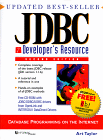Good Reference to JDBC, with Plenty of Examples
Limited basic information, but great for finding class/call examples to solve quick JDBC problems.
ORIGINAL DRAFT
The Java Database Connectivity (JDBC) API is one of the most useful of Java’s many APIs. It’s simple and accessible, easy to use and accesses vast stores of information with minimal effort. If you’ve never touched JDBC before or if you’re looking to put something on your shelf for reference, this book is a pretty good investment. This is the second edition for the JDBC Developer’s Resource and updates the content to reflect more recent information. Unfortunately, there is no Java 1.2 coverage, though the impact on JDBC is not direct. The book ships with JDK 1.1.6 and the JDBC/ODBC bridge on CD, among other things.
More than half this book is designed for reference, but the first few chapters lay a useful foundation. The first chapter provides a basic Java primer for those unfamiliar with the language. Chapter 2 covers relational database basics. Chapter 3 introduces the JDBC API with Chapter 4 presented as a tutorial. The tutorial is fairly comprehensive and covers the major concepts, including prepared statements, cursor updates and transaction modes. Chapter 5 provides an Applet example and Chapter 6 covers a server-side three-tiered example. Among the new second edition material is chapter 7, which covers JDBC version 2.0.
From page 208 to the end of the book is the JDBC reference section. Chapter 8 provides a quick reference and Chapter 9 lists each of the classes and methods with examples for each. I was able to find a few minor typos that cause a few problems when applying the example code, but overall it was useful to see practical usage examples for each of the calls. The format makes it easy to find information and delivers the overall promise of easy reference. Appendix A provides a function reference for a few of the more common Java classes, which is nice of have access to but doesn’t add much to the book’s value.
If you use or plan to use JDBC, whether you have considerable or limited experience with Java and/or databases, this book should be enough to get you started but does not provide comprehensive coverage of anything outside JDBC. It is clearly targeted as a reference book. In that, it delivers well enough to make it a valuable choice. I found it easy to look up JDBC-related information and tend to reach for this book first when I want to see which class and method to use. I find the examples especially useful in a reference section like this one. If a JDBC reference is what you need, this is a good book to buy.
